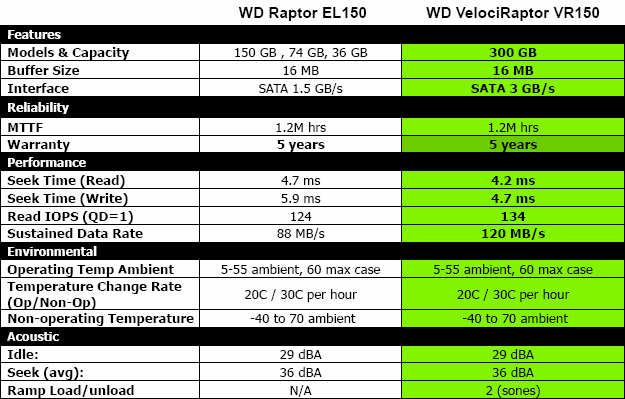Western Digital Velociraptor 300GB SATA HD
Western Digital's Raptor line of high performance hard drives has been a long-time favorite of PC enthusiasts since its introduction several years ago. When WD's Raptors first hit, their 10K RPM spindle speeds allowed for much lower access times than the more common 7200 RPM desktop drives of the time, and overall relative performance was strong. Many users were put off by the relatively low capacities of the Raptor, which debuted at 36GB and topped out at 150GB, but they were still wildly successful amongst enthusiasts regardless.
As time wore on though, Western Digital's competitors introduced faster and faster, high capacity drives, that began to out-perform the Raptor in a number of key metrics. WD too released some fast, high-capacity drives that out-performed even the fastest Raptor in many scenarios. WD released a number of more eco-friendly drives under their "Green Power" badge as well, which may have led some to believe WD's focus on the enthusiast sector had diminished. However, as you'll see today, that is definitely not the case.
Today, Western Digital is unveiling the brand new Velociraptor WD3000GLFS 300GB hard drive. Like the previous generation Raptors, the new WD Velociraptor sports a 10K RPM spindle speed, but the drives are actually quite different. As you'll see, this new Velociraptor is simply in a league of its own, thanks to some innovative design choices.

|
|
|
*Note: MTBF now estimated at 1.4M hrs.
In a side by side feature comparison, the WD Velociraptor resembles the older Raptors. The drives share the aforementioned 10K RPM spindle speed, they have the same 16MB buffer, the same reliability ratings, and acoustic and environmental characteristics. The WD Velociraptor's new design, however, offers significantly increased performance, both in terms of access times, IOPS, and data transfer rates.
We should also point out, that while the Raptor line and Velociraptor share the same acoustic specifications, the drives definitely do not sound alike. With the new Velociraptor, the high-pitched whine emitted from the previous-gen Raptors has seemingly been eliminated. However, the Velociraptor's heads can easily be heard chunking along within the drive.






